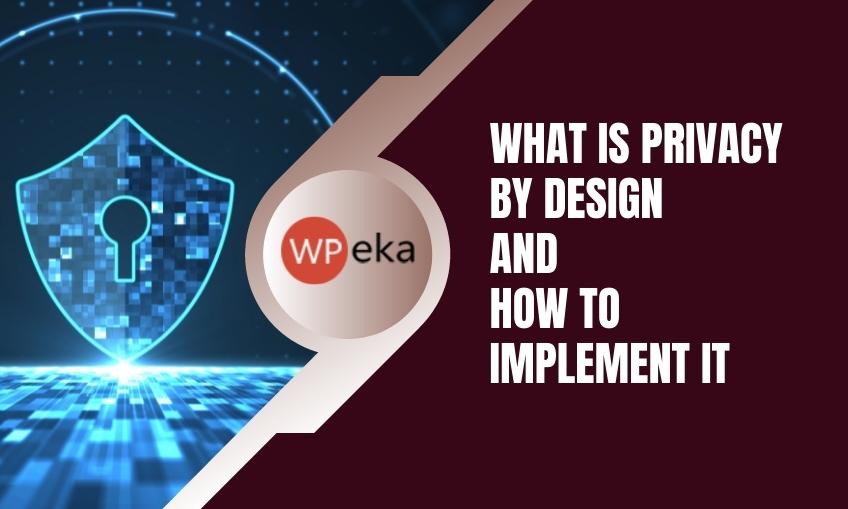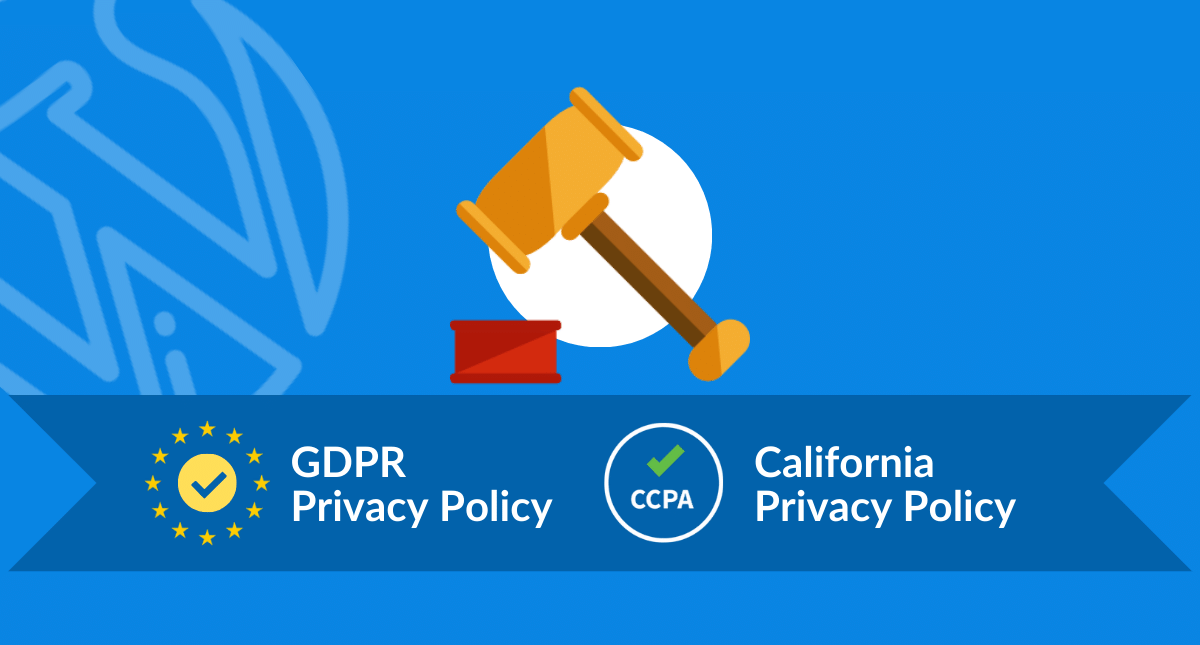What is privacy by design and how to implement it?

As the globe continues its march toward everything digital, the piles of data uploaded to the web are exposed increasingly. A lot of individuals have their personal information residing on hundreds of servers around the world.
With this fact, there seems to be an increase in data fraud and identity theft instances. On top of that, courtesy of the pandemic, data theft has risen substantially in 2020 and 2021. As per the reports, the incidents of identity fraud increased by approximately 45% in 2020.
In 2021, the trend continued, and there was an accumulated loss of $56 billion just in America. If you consider a specific figure that the entire world had to lose because of these frauds, the outcome surely will be jaw-dropping.
To combat such issues, the European Union (EU) came up with the General Data Protection Regulations (GDPR), which was launched in 2018. It helped a lot of businesses and organizations to form compliant policies for threat protection.
However, giving it a different angle altogether, it is necessary for IT security to be more than merely reactive. Therefore, rather than only adhering to the GDPR strategies and guidelines, you must also focus on privacy by design.
Have no idea what this is? Fret not! This post aims to make you familiar with the concept of privacy by design and how it can be implemented with ease.
What is Privacy by Design?

To put it simply, the concept of privacy by design is a tad bit more than mere data protection via technology design. At the core, it simply means that you will have to integrate privacy and data protection features into your system.
However, this entire concept should not be an alternative to the existing infrastructure, processes, procedures, practices or engineering. Some of the significant examples of privacy by design comprise:
- Executing a Data Protection Impact Assessment (DPIA) before using any personal information on the internet
- Writing and publishing updated, easy-to-read privacy policy
- Offering the contact details of the Data Protection Officer (DPO) or anybody else responsible for the use of data in the organization
Nonetheless, privacy by design goes beyond the examples mentioned above. In one way or the other, it affects practically every area of data processing and technology use.
Principles of Privacy by Design

To understand privacy by design thoroughly, you will have to comprehend its seven principles, which are as follow:
- Preventative not Remedial or Proactive not Reactive
This principle claims that data privacy should be the first point of the planning process. If your security practice involves dealing with data breaches, you are simply being reactive. You will have to be proactive about it and try to come up with plans to avoid these breaches in the first place.
- Privacy as the Default
Perhaps, this is the most difficult principle for businesses to understand. It talks about the importance of keeping privacy at the forefront of the business. This means limiting the use and sharing of data, which should be on legal grounds. Also, the data should be deleted when not in use. It also concentrates upon the opt-in and opt-out functions to keep the consumers’ data protected.
- Privacy Embedded into Design
This third principle talks about the idea wherein privacy requires finding an abode in architecture and business. In simple words, privacy is the core and vital functionality of your business. You must use testing vulnerabilities, authentication, and encryption regularly to keep everything updated. If you see any design flaw, know there is a security vulnerability that has to be fixed.
- Full Functionality
With this principle, you get to learn that if you are sacrificing the core functionality for privacy, you are doing everything wrong. Full functionality is a culture shift that needs a balance between security and growth.
- End-to-End Security
End-to-end security argues that privacy protection generally follows data through the lifecycle of archives and deleted folders. Sure, authentication and encryption are the standards at every step. However, you have to take a step further away from them. For instance, you must only collect such data that is required legally. And once you are done using it, you must use the deletion or destruction methods that are compliant with GDPR to ensure end-to-end protection.
- Visibility and Transparency
In this principle, you get to understand that the concept of privacy is not just for the sake of privacy. Your customers should be familiar with your privacy practices. This can be done through a concise and precise privacy policy, which should be designed according to the GDPR guidelines. Also, you must create a mechanism for your target audience to raise their questions, grievances and ask for changes whenever needed.
- Respect for User Privacy
Lastly, this principle highlights that everything has to be user-centric. This simply means that you should acknowledge the fact that the data you accumulated belongs solely to the customers. They have the ultimate right to withdraw or grant consent for their data use.
Privacy by Design: How does it affect your business?

Privacy by design is for almost every business. However, it is specifically essential for such businesses that control data and fall under the GDPR scope. However, there are no precise measures that should be taken apart from a few features, such as anonymization, encryption or pseudonymization. Rather, the GDPR policy wants your privacy features to be appropriate and reasonable to both the data you accumulate and the process you have integrated.
Furthermore, even if your business doesn’t come under the GDPR radar, following the privacy by design methodology is still recommended. By implementing this concept, you get to reflect upon an understanding of the personal information value to both your customers and your business.
It helps acknowledge that personal and privacy control over data is a vital aspect. And, it is something that you must uphold on your own in the market. When it comes to people’s awareness and concern regarding their privacy, a poll by ExpressVPN found that 71% of people are concerned about how businesses are collecting and using their data.
By approaching privacy from a design, perspective makes sure that data becomes important to your business, from its planning to the execution. It also allows you to futureproof the business from the perspective of a regulatory body and customers.
How to implement Privacy by Design: Article 25 Checklist

Undoubtedly, article 25 is quite vague. However, when it comes to staying protected from GDPR fines and privacy threats, thoroughness is important. Whether you are selling a product or running a website, privacy by design has to be put into place:
- At the designing stage
- Between the end-to-end engagement
- Throughout the lifecycle of the designing stage
- Post the engagement
- After your app or site has come down
Although GDPR asks for organizational and technical measures, it doesn’t offer a checklist. You have to form your own questions and answers with some direction from the law and the recitals. The integration of privacy by design follows three significant factors, such as:
- Systems Checklist
Privacy by design begins with the systems put in place. Since it commences at the top, this is where your checklist also begins. To integrate privacy into the system, you must at least start with these points:
- Establish a documented organizational commitment to the standards of data protection
- Have security measures that can be used to avert breaches and incidents
- Appoint a Data Protection Offer (DPO) or a data protection advisor
- Use self-assessment for auditing as well as track the implementations of the documented system
- Create a data protection framework
- Update privacy training for those employees who are liable for handling personal data
- Create and document a record-keeping system for the activities of processing
- Comprehend and integrate a risk management system
With this checklist in tow, you will get a better chance at preparing and then designing the data processes.
- Processes Checklist
The significant concentration of the GDPR compliance and privacy by design takes place in this section. However, keep in mind that processes don’t work without the mentioned above section. Thus, a few things that you can include in the process’s checklist are:
- Integrate the systems checklist measures
- Allocate the responsibilities for gatekeeping, such as procurement, legal, IT, and more
- Add privacy controls to let customers access their data on their own terms
- Identify privacy risks throughout the process
- Use compliance, risk and DPIAs assessments before accumulating data for usage or storage
- Document the data processing
- Risk Management Checklist
Despite building privacy into the process design, you still will have to manage risks throughout the lifecycle of data. Risk management simply begins at the level of systems and continues into processing. Thus, you must:
- Describe the objective of data processing on legal grounds
- Comprehend measures that can avert data from being processed unnecessarily
- Monitor the measures of data minimization and integrate adequate controls
- Discover measures that can be used for ensuring the accuracy of data
- Name and record the teams and people who have access to the data
- Outline all of the controls for data access
- Create data processing agreements and review all of them with every third-party processor
- Keep track of integrated security practices
- Outline the process executed in case of a data and security breach
- Comprehend source of notice and information to customers regarding data processing
- Integrate the measures of both the systems and the processes checklists
Also, when applying this checklist, you should also keep the principles of Article 25 in mind. This article comprises the below-mentioned limitations and obligations:
- The situation of the art (it keeps changing)
- Adequate organizational and technical measures
- Implementation costs
- Risks of several types of rights and freedoms
- Context, purpose, scope and nature of the processing
All in all, you don’t have to spend millions on integrating privacy by design. Practicing the above-mentioned checklist can do the job for you as well.
Get Started with WP LegalPages: Free Privacy Policy Generator

The WP LegalPages is a WordPress privacy policy generator plugin that helps you create attorney-level legal pages. The plugin is available in both free and premium versions and is developed by a team of ingenious developers.
The plugin is also backed by plenty of efficient features. By using this one, you can design more than 25 automated legal policy pages, some of them including:
- Amazon Affiliate Disclosure
- Blog Comments Policy
- California Consumers Privacy Act (CCPA)
- DoubleClick DART Cookie Policy
- External Links Policy
- FTC Disclaimer Widgets and FTC Testimonials Disclosure
- GDPR Privacy and Cookie Policies
- Linking Policy
- Terms of Service
And much more.
Using this plugin is effortless as well. You will have to add your business details, and the policy pages will be created automatically. The plugin is available in multiple language translations as well, like English, Spanish, French, German, Portuguese and Italian. Thus, you can serve people across the world.
Conclusion
Whether you have to comply with the GDPR or not, privacy by design is something that is regarded as the best practice for all of the businesses that engage in data processing, irrespective of how small or big they are.
With privacy by design, you will have to consider privacy from the beginning of projects and implement the same into your operations and systems. By all means, privacy by design is neither a tool nor a security practice. However, getting it adequately simply encourages the culture inside an organization to acknowledge and respect the value of personal data.
So, keep the above-mentioned checklist in mind and implement privacy by design into the company. However, while doing so, don’t forget some important factors, which are the scope and nature of the processing, implementation cost, and the risks that your customers will face in times of a breach.
Since privacy by design, under the GDPR, is adaptable for all businesses, you shouldn’t have any excuse to not begin with it.

Leave a Reply